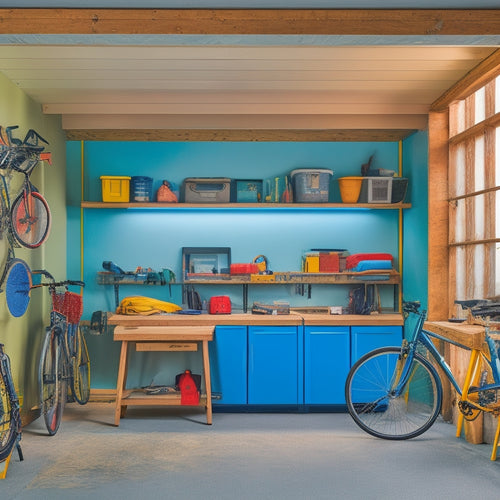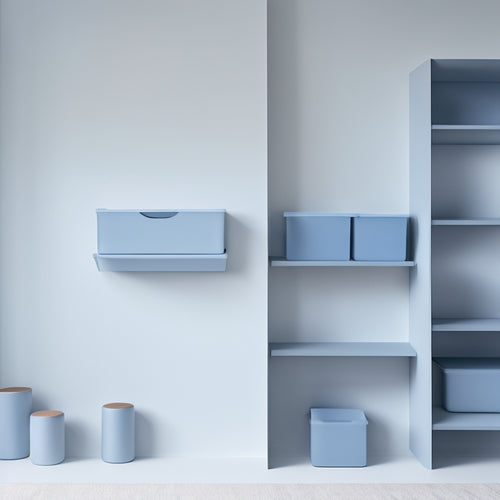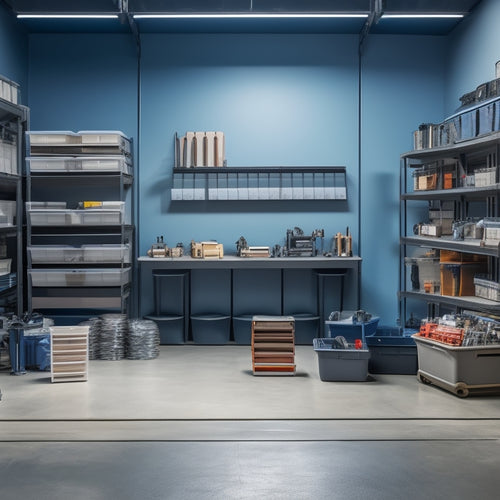
Portable Tool Chest Essentials
Share
When stocking your portable tool chest, you'll want to prioritize essential hand tools like hammers, tape measures, and pliers, as well as power tools like cordless drills and impact wrenches. Measuring and testing equipment, such as digital multimeters and high-quality tape measures, are also must-haves. Don't forget to include fasteners, cutting and shaping tools, safety gear, and lighting options. Organize your tools with a well-thought-out storage system, and consider cordless and battery options to optimize your workflow. With these essentials in place, you'll be ready to tackle any project that comes your way - and there's even more to investigate to take your tool chest to the next level.
Key Takeaways
- A portable tool chest must have essential hand tools like hammers, tape measures, and screwdrivers, as well as power tools like cordless drills and saws.
- Measuring and testing equipment, including digital multimeters and high-quality tape measures, ensure accurate measurements and diagnoses.
- A well-stocked tool chest should include fasteners and fixings like assorted screws, nuts, and bolts, as well as adhesives and sealants for secure fastening.
- Safety and protection gear, such as protective eyewear, hearing protection, gloves, and steel-toed boots, are crucial for preventing injuries.
- Organizing and storage tips, including tool box layout, compartmentalization, and labeling, help maintain efficiency and reduce downtime.
Essential Hand Tools to Carry
Your portable tool chest should contain a core set of essential hand tools that can help you tackle a variety of tasks. When selecting tools, consider the types of projects you frequently work on and the tasks you need to accomplish.
Tool selection tips include choosing high-quality tools that fit comfortably in your hand and are easy to use.
For general-purpose tasks, you'll need a hammer, tape measure, level, pliers, screwdrivers, and wrenches.
Don't forget essential hand tools like wire cutters, bolt cutters, and a utility knife. These will help you handle unexpected tasks and minor repairs.
Remember that essential tool maintenance is vital to guarantee your tools remain in good condition.
Regularly clean and inspect your tools for damage or wear. Lubricate moving parts and store your tools in a dry, protected area.
Power Tools for Every Project
Having the right power tools at your disposal can make all the difference in tackling projects efficiently and effectively. A well-stocked portable tool chest should include a variety of power tools to help you complete tasks quickly and safely.
Start with the essentials: a cordless drill for drilling and driving, power saws for cutting through wood and metal, and impact wrenches for loosening stubborn bolts. An angle grinder is a must-have for grinding and polishing, while a rotary tool is perfect for precision work.
When working with wood, a nail gun can save you time and effort.
Don't forget to include sanders for smoothing out surfaces, jigsaws for curved cuts, and oscillating tools for tight spaces. A heat gun is also useful for drying surfaces and loosening stuck parts.
With these power tools at your fingertips, you'll be well-equipped to tackle any project that comes your way. Remember to always follow safety guidelines and use protective gear when operating power tools.
Measuring and Testing Equipment
You'll want to stock your portable tool chest with reliable measuring and testing equipment to guarantee accurate readings and efficient project workflow.
A digital multimeter is a must-have for diagnosing electrical issues, and you'll need to choose the right option for your specific needs.
Additionally, a high-quality tape measure that provides precise measurements will help you avoid costly mistakes.
Digital Multimeter Options
Digital Multimeter Options
Three essential digital multimeter options should be in every portable tool chest: a basic multimeter, an advanced multimeter with specialized functions, and a miniature multimeter for tight spaces.
These digital multimeter types cater to various measurement needs, ensuring you're prepared for any task.
You'll want to contemplate the following multimeter features when selecting your options:
-
Accuracy and precision: Look for multimeters with high accuracy ratings and precise measurements.
-
Voltage and current ranges: Choose multimeters that can handle various voltage and current ranges to suit your specific needs.
-
Additional functions: Consider advanced multimeters with features like temperature measurement, capacitance testing, and diode testing.
- Durability and safety: Opt for multimeters with rugged designs, safety certifications, and protective features like overload protection.
Tape Measure Accuracy
Tape Measure Accuracy (Measuring and Testing Equipment)
You rely on your tape measure to provide accurate readings, but have you ever stopped to think about the importance of tape measure accuracy? With so many tape measure types available, it's vital to choose the right one for your needs and maintain it properly. A high-quality tape measure can guarantee precise measurements, while a faulty one can lead to costly mistakes.
Regular tape measure maintenance is key to maintaining accuracy. Check your tape measure regularly for signs of wear and tear, such as frayed or damaged blades, and replace it if necessary. Clean the tape measure regularly to prevent dirt and debris from affecting readings.
Additionally, make certain to store your tape measure properly to prevent damage.
When selecting a tape measure, consider the type of projects you'll be working on and the level of precision required. Fiberglass or nylon-coated blades are ideal for general-purpose measurements, while high-accuracy tape measures with fractional readings are better suited for precise work.
Fasteners and Fixings Essentials
As you begin assembling your portable tool chest, fasteners and fixings essentials take center stage, providing the necessary infrastructure to hold your tools and equipment securely in place.
You'll need a variety of fasteners to accommodate different screw types and fastening methods.
Here are the must-haves for your fasteners and fixings essentials:
-
Assorted screws: Having a mix of flathead, Phillips, and hex-head screws in various sizes will cover most of your tool chest assembly needs.
-
Nuts and bolts: Include a selection of hex nuts, wing nuts, and bolts in different lengths and thread sizes to guarantee secure fastening.
-
Rivets and clips: These are necessary for attaching smaller components, such as trays and dividers, to the tool chest's frame.
- Adhesives and sealants: Add a tube of threadlocker, hot glue, or epoxy to your kit to reinforce joints and prevent rattling or movement.
Cutting and Shaping Tools
You'll need a reliable utility knife with interchangeable blades for various tasks, and a backup or two to guarantee you're always prepared.
Edge trimming tools, like a utility saw or a pair of shears, will also be essential for refining your cuts and shaping materials.
Utility Knife Options
Frequently, a utility knife is the go-to tool for various cutting and shaping tasks in your portable tool chest. When selecting a utility knife, evaluate the type of blade and ergonomic design that suits your needs.
You'll want a knife that provides comfort, control, and precision. Here are some essential factors to evaluate:
-
Blade type: Choose from various knife blade types, such as straight, curved, or hooked. Straight blades are ideal for general-purpose cutting, while curved blades are better suited for cutting curves or irregular shapes.
-
Ergonomic design: Look for knives with ergonomic designs that fit comfortably in your hand, reducing fatigue and improving control.
-
Blade material: Select knives with high-carbon stainless steel blades for durability and corrosion resistance.
- Safety features: Opt for knives with safety features like thumb-activated blade locks or automatic blade retraction to prevent accidents.
Edge Trimming Tools
Edge trimming tools are the unsung heroes of your portable tool chest, tackling the often-overlooked task of refining and perfecting the edges of your projects. These tools are essential for achieving a professional finish, and you'll rely on them to remove excess material, smooth out rough edges, and create clean cuts.
When selecting edge trimming tools, consider the materials you'll be working with most often. For example, if you frequently work with wood, a router or edge trimmer with interchangeable bits will be a significant addition to your chest.
For metal or plastic projects, a handheld edge trimmer or deburring tool will help you achieve precise, burr-free cuts.
Mastering edge trimming techniques takes practice, but with the right tools, you'll be well on your way. Start by selecting the appropriate edge trimming materials for your project, such as sandpaper, files, or cutting wheels.
Then, practice various edge trimming techniques, like beveling, chamfering, and rounding, to achieve the desired finish. With patience and practice, you'll develop the skills to tackle even the most complex edge trimming tasks with confidence.
Safety and Protection Gear
When working with power tools, one vital aspect to contemplate is protecting yourself from potential hazards.
You're working with machines that can cause serious harm if not handled properly. It's imperative to prioritize your safety and well-being above all else.
You'll need the following safety and protection gear in your portable tool chest:
-
Protective eyewear: Safety glasses or goggles that shield your eyes from flying debris, dust, and other particles.
-
Hearing protection: Earplugs or earmuffs that reduce the risk of hearing damage from loud machinery and tools.
-
Gloves: Heavy-duty gloves that provide grip, protection, and comfort while handling tools and materials.
- Steel-toed boots: Sturdy boots that safeguard your feet from heavy objects, sharp edges, and other hazards.
Lighting and Illumination Options
At dawn or dusk, or in poorly lit workspaces, adequate lighting is essential to assure you can see what you're doing and avoid accidents.
In your portable tool chest, you'll want to include a variety of lighting options to guarantee you're always well-lit. A rechargeable flashlight is a must-have for task lighting, providing focused illumination exactly where you need it.
For area floodlighting, consider a portable lantern that can be placed on a surface or hung from a hook. Additionally, an LED strip can be stuck under shelves or in tight spaces to provide ambient light.
A magnetic light is also handy for sticking to metal surfaces, freeing up your hands for work. For larger areas, an area floodlight can be set up to illuminate the entire worksite.
Organizing and Storage Tips
You'll get the most out of your portable tool chest by designing a thoughtful tool box layout that groups similar tools together and keeps frequently used items easily accessible.
Properly labeling your storage bins will also save you time and frustration when searching for a specific tool or part.
Tool Box Layout
A well-organized tool box layout is essential for efficient tool retrieval and storage.
You'll save time and reduce frustration when you can quickly find the tool you need. To achieve this, you'll want to employ effective tool placement strategies and space optimization techniques.
Here's a suggested layout to get you started:
-
Heavy tools at the bottom: Store your heaviest tools, like hammers and wrenches, at the bottom of your tool box to prevent them from shifting during transport.
-
Frequently used tools at eye level: Place your most frequently used tools at eye level for easy access.
-
Small items in compartments: Designate compartments for small items like screws, nuts, and bolts to keep them organized and prevent them from getting lost.
- Less frequently used tools at the top: Store less frequently used tools at the top of your tool box to keep them out of the way but still accessible.
Storage Bin Labels
Organizing your tool box is only half the battle - keeping it that way requires a system that's easy to maintain. Effective storage bin labels are essential to this system.
You'll want to choose label types that can withstand the rigors of your work environment, such as durable plastic or vinyl labels that resist fading, moisture, and abrasion. Labeling techniques can include color coding to categorize tools by type or function, making visual identification quick and easy.
Consider bin sizes and label them accordingly to guarantee easy access to the tools you need. Material durability is key, so opt for high-quality labels that won't peel off or crack over time.
Cordless and Battery Options
With the rise of cordless power tools, batteries have become an essential component of your portable tool chest. You need reliable batteries that provide consistent power and long battery life to get the job done efficiently.
When selecting cordless tools and batteries, consider the following:
-
Cordless convenience: Opt for tools with long-lasting batteries that minimize downtime and reduce the need for frequent recharging.
-
Charging solutions: Choose batteries with fast charging capabilities and consider multi-port chargers to keep your tools ready when you need them.
-
Lightweight options: Select batteries that are lightweight and compact, making them easy to transport and store in your portable tool chest.
- Power management: Look for batteries with built-in power management systems that prevent overcharging, overheating, and other safety hazards.
Specialized Tools for Trades
Efficiency demands that you tailor your portable tool chest to the specific demands of your trade, and that means incorporating specialized tools that cater to your unique needs.
As you assemble your portable tool chest, consider the specific requirements of your trade and the tasks you perform daily. This will help you identify the specialty toolkits and trade-specific equipment you need to include.
For electricians, this might mean incorporating wire strippers, multimeters, and cable testers.
Plumbers may require pipe cutters, tube benders, and drain snakes.
Carpenters, on the other hand, may need a set of chisels, hand saws, and clamps.
Frequently Asked Questions
Can I Customize My Portable Tool Chest to Fit My Specific Needs?
You can definitely tailor your portable tool chest to fit your specific needs by carefully selecting the right tools and implementing clever storage solutions that maximize space and efficiency while ensuring safe access.
How Do I Keep My Tools Organized and Easy to Find?
"A place for everything and everything in its place" rings true when keeping tools organized. You categorize tools by function, then assign storage solutions, like dividers and bins, to each category, making them easy to find and access when you need them.
What Is the Ideal Size for a Portable Tool Chest?
When choosing a portable tool chest, you'll want to contemplate compact tool storage that fits your needs. Look for sizes between 24-40 inches wide, 12-20 inches deep, and 10-18 inches tall, ensuring you have enough space without compromising portability.
Are Portable Tool Chests Suitable for Heavy-Duty Construction Projects?
When tackling heavy-duty construction projects, you need a tool chest that can keep up. Look for durability features like reinforced frames and high weight capacity to guarantee your tools are protected and easily transportable, even on rugged sites.
Can I Lock My Portable Tool Chest to Prevent Theft?
You can take tool security to the next level by investing in a portable tool chest with strong locking mechanisms, ensuring your precious equipment is protected from theft and unauthorized access.
Conclusion
You've got the essentials to build a portable tool chest that'll tackle any project. With the right hand tools, power tools, measuring equipment, fasteners, cutting tools, lighting, and storage solutions, you'll be unstoppable. Did you know that the average DIYer owns over 50 tools, but only uses 20% of them regularly? That's a lot of unnecessary clutter. By focusing on these must-haves, you'll be working smarter, not harder, and getting the job done efficiently.
Related Posts
-

7 Essential Foldable Workbenches for Garages
When selecting a foldable workbench for your garage, you'll want to contemplate factors such as space-saving design, ...
-

Small Storage Bins to Maximize Shelf Space
When maximizing shelf space, you want to make the most of every inch. Small storage bins are the answer, but choosing...
-

How to Maximize Storage Space With Parts Storage Bins
To maximize storage space with parts storage bins, start by evaluating your available storage space and examining you...


